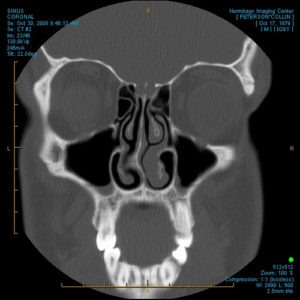What is the role of the nasal septum?
- Posted on: Jun 7 2012
Many patients are somehow confused about what the septum is and what the role of it is in our nasal passages. Anatomically, the septum refers to the wall that separates the left and right sides of our nasal passages. There is mucous membrane lining over the entire septum on either side, and the center part is made from bone and cartilage.
The role of the septum is essentially similar to lane markers in a busy highway. The septum allows the air that we breathe in through our nostrils to go directly from the tip of the nose into the back of the nose and into the lungs. Without the septum, the air that we breathe in might “get lost” in our nose; the turbulence might interfere with the direct transit of the air directly into the lungs.
In an ideal situation, we would like the septum to be a straight wall that goes in an up and down direction. In reality, everybody has some degree of deviation of their septum. Sometimes this is due to the way that the nose develops and sometimes it could be due to a previous injury or fracture of the nose. The degree of the deviation of the septum, as well as the anatomy of the side wall of the nose, can result in various degrees of blockage of the nasal passages as well as the sinus drainage pathways.
In general, part of capacity to breathe adequately through the nasal passaged is dictated by the general health of the membranes, and other part is dictated by the anatomy of the septum. A patient with a deviated nasal septum is considered to have a fixed anatomical abnormality that will not respond to any kind of medical therapy for an anatomical blockage. As such, the only remedy is to undergo corrective surgery.
Correction of a deviated septum surgically is usually called septoplasty. In most cases, this procedure is done in the operating room under anesthesia. Through a small incision into the membranes at the level of the nostrils, the bone and the cartilage of the septum is exposed. The portion of the septum that is not straight can then be either shaved or realigned internally. The septoplasty procedure alone usually does not result in black and blues under the eyes or any change to the external appearance of the nose. Most patients are able to go home the same day, and should be able to return to most normal physical activities within the few days.
It is usually not easy to determine if the patient is suffering from a deviation of septum versus other reasons for nasal obstruction by external examination. Examination of the inside of the nasal passages can be done with the help of nasal endoscopy. This is the best determinant to ascertain deviation of the nasal septum. Once the diagnosis is confirmed, a decision to go ahead with the septoplasty procedure is made by the patient given the degree of blockage that they experience.
Tagged with: deviated septum, ear nose throat, ENT, Isaac Namdar, Isaac Namdar MD, nasal blockage, nasal obstruction, New York, new york city, Otolaryngology, Otorhinolaryngology, septoplasty, septum, turbinate, turbinate hypertrophy
Posted in: Nose


